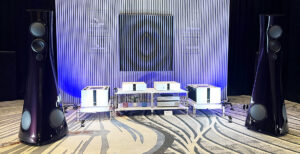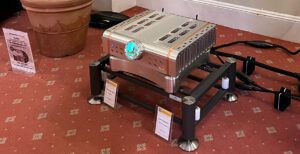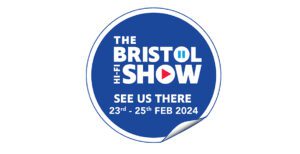
There is a hobby that has been around in some guise or another since the 19th Century. Its enthusiasts are capable of arguing at length over minutiae about the equipment required to engage in the hobby. It has undergone significant change with the coming of digital and the Internet. And it is increasingly considered the preserve of the older gentleman.
It’s called audio. No, wait, it’s called photography.
There are many parallels between our world and the picture-taking one. Even some of the brands are the same (alongside Sony and Panasonic, don’t forget that the French loudspeaker company Cabasse is owned by Canon these days). But perhaps the biggest parallel is the way both audio and photography seem to have changed rapidly in the last few years.
Audio has seen a distinct split between the good, inexpensive end of the market and the high-end (and now ultra-high-end), with not a great deal of interest in the bits between these two poles. The good news here is the inexpensive end of the market is now delivering extremely fine results that don’t necessarily spark that need to upgrade, while the top-end equipment is now capable of making a level of realism and excitement that simply wasn’t possible a few years ago. Also,, while there are high-tech brands making innovative design exercises, there are other, often equally high-tech brands with an industrial design department seemingly locked in a time capsule from the 1950s or 1970s – perhaps a function of the age of the intended purchasers, but these retro products are frequently well-received by the cognoscenti.
And, if you knock off the word ‘audio’ and replace it with ‘photography’, precisely the same thing applies.
In cameras now, we have the excellent mirrorless designs that marry the ‘smaller, lighter, cheaper’ demands of photographers with a level of performance they would have been hard-pressed to achieve under any circumstance a decade ago. We also have an increasing number of ‘full-frame’ DSLR (digital single lens reflex) cameras with 35mm film-sized sensors, able to deliver absolute top-notch resolution, at a price. And then there’s the rebirth of Leica and Hasselblad at the extreme high-end, delivering niche products that prove popular with serious amateurs, serious professionals and serious spenders the world over.

Interestingly, even the pitched battle online arguments carry over from one field to another without too much translation. The mirrorless enthusiasts accuse the DSLR pack of being a bunch of dinosaurs, while the DSLR users retort with “you don’t understand, because you aren’t a real enthusiast” type quips. And all of the above look at the Leica users as being led by fashion and wealth (but if pressed will admit they like the performance they get from their hyper-expensive components). Each proclaims a ‘win’ in the war of the formats, and each dismisses the demands of the other with a haughty snort.
In other words, it’s like Audio Asylum, with a cable release.
Can we – as audiophiles – learn from our shutterbug brethren? I think so, not least because many audiophiles are shutterbugs (and vice versa). The downshifting taking place as many photographers begin to adopt mirrorless camera designs with interchangeable lenses was at first dismissed as simple cost, weight and space saving. But then those who made the switch began to deliver really good images and found themselves re-engaging with their hobby. The same seems to be happening with audio, and we should dismiss this as mere downshifting at our peril. The “it’s not about the gear” concept – that is driven by good photographers taking excellent pictures with prosaic equipment – is also worthy of exploration, even by the most resolute high-enders. Finally, the “Keep It Simple, Stupid” approach that goes with this (one camera, one lens, don’t be a pack-rat) is an ideology well worth applying to audio. Many audiophiles are collectors, not just of music but of older audio equipment; this divides between owning a private museum of audiophile ephemera and hanging on to parts of your previous system ‘just in case’. This hoarding instinct isn’t quite as well developed in audio as it is in photography (somewhere, buried deep in a drawer in most photographer’s homes is a lens farm; a place where lenses that just don’t see action anymore get to live out their years in dark seclusion) – but the liberation that comes with shaking off all that baggage is immense. Allegedly – I still have more cameras and lenses than is good for a person.

However, the thing that photographers know almost instinctually that is sometimes lost on the audiophile is just how to keep re-engaged with the hobby. It’s not about buying new things or filling a camera bag with every single piece of photographic equipment you can muster. It’s about going out there and taking pictures. Or, in our little world, going out there and listening to new music.
So, here’s the thing. This Christmas, give yourself a present, of a kind of music you would never dream of. Try it on for the holiday, try to see why people like it. If you are an opera lover, try death metal. If you like death metal, try a late Beethoven string quartet. Jazzers, rock out. Rock gods… pick a Latin groove. EFM fans go listen to some folk and so on. At the very least, you return to the music you love with renewed vigour. But you might just find the best music you never heard of before. Give it a try!
By Alan Sircom
More articles from this authorRead Next From Blog
See all
AXPONA 2024 Show Report Part One
- Apr 19, 2024

Audio Show Deluxe 2024: A photo show report
- Mar 28, 2024

Paul Messenger 1949-2024: A personal tribute
- Mar 26, 2024

Bristol Hi-Fi Show 2024: See You There!
- Feb 21, 2024










